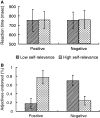Self-esteem modulates dorsal medial prefrontal cortical response to self-positivity bias in implicit self-relevant processing
- PMID: 24396003
- PMCID: PMC4221225
- DOI: 10.1093/scan/nst181
Self-esteem modulates dorsal medial prefrontal cortical response to self-positivity bias in implicit self-relevant processing
Abstract
Processing self-related material recruits similar neural networks regardless of whether the self-relevance is made explicit or not. However, when considering the neural mechanisms that distinctly underlie cognitive and affective components of self-reflection, it is still unclear whether the same mechanisms are involved when self-reflection is explicit or implicit, and how these mechanisms may be modulated by individual personality traits, such as self-esteem. In the present functional MRI study, 25 participants were exposed to positive and negative words that varied with respect to the degree of self-relevance for each participant; however, the participants were asked to make a judgment about the color of the words. Regions-of-interest analysis showed that medial prefrontal cortex (mPFC) and posterior cingulate cortex were associated with gauging the self-relevance of information. However, no main effect of valence or an interaction effect between self-relevance and valence was observed. Further, positive correlations were observed between levels of self-esteem and response within dorsal mPFC (dmPFC) both in the contrast positive-high in self-relevance trials vs positive-low in self-relevance trials and in the contrast negative-low in self-relevance trials vs positive-low in self-relevance trials. These results suggested that the activation of dmPFC may be particularly associated with the processes of self-positivity bias.
Keywords: dorsal medial prefrontal cortex (dMPFC); implicit self-relevant processing; self-esteem; self-positivity bias.
© The Author (2014). Published by Oxford University Press. For Permissions, please email: journals.permissions@oup.com.
Figures



Similar articles
-
Differential dorsal and ventral medial prefrontal representations of the implicit self modulated by individualism and collectivism: An fMRI study.Soc Neurosci. 2010;5(3):257-71. doi: 10.1080/17470910903374895. Epub 2010 Feb 22. Soc Neurosci. 2010. PMID: 20178036 Clinical Trial.
-
Is the self special in the dorsomedial prefrontal cortex? An fMRI study.Soc Neurosci. 2009;4(5):455-63. doi: 10.1080/17470910903027808. Epub 2009 Jul 8. Soc Neurosci. 2009. PMID: 19588282
-
Self-esteem modulates the latency of P2 component in implicit self-relevant processing.Biol Psychol. 2014 Mar;97:22-6. doi: 10.1016/j.biopsycho.2014.01.004. Epub 2014 Feb 6. Biol Psychol. 2014. PMID: 24508635
-
Relevance to self: A brief review and framework of neural systems underlying appraisal.Neurosci Biobehav Rev. 2007;31(4):585-96. doi: 10.1016/j.neubiorev.2006.12.003. Neurosci Biobehav Rev. 2007. PMID: 17418416 Free PMC article. Review.
-
Self-reflection and the brain: a theoretical review and meta-analysis of neuroimaging studies with implications for schizophrenia.Neurosci Biobehav Rev. 2010 May;34(6):935-46. doi: 10.1016/j.neubiorev.2009.12.004. Epub 2009 Dec 14. Neurosci Biobehav Rev. 2010. PMID: 20015455 Review.
Cited by
-
Neural correlates of integrated self and social processing.Soc Cogn Affect Neurosci. 2020 Nov 6;15(9):941-949. doi: 10.1093/scan/nsaa121. Soc Cogn Affect Neurosci. 2020. PMID: 32901818 Free PMC article.
-
Attenuated self-serving bias in people with internet gaming disorder is related to altered neural activity in subcortical-cortical midline structures.BMC Psychiatry. 2020 Oct 20;20(1):512. doi: 10.1186/s12888-020-02914-4. BMC Psychiatry. 2020. PMID: 33081740 Free PMC article.
-
Adolescent Gender Differences in Cognitive Control Performance and Functional Connectivity Between Default Mode and Fronto-Parietal Networks Within a Self-Referential Context.Front Behav Neurosci. 2018 Apr 23;12:73. doi: 10.3389/fnbeh.2018.00073. eCollection 2018. Front Behav Neurosci. 2018. PMID: 29740292 Free PMC article.
-
Oxytocin blurs the self-other distinction during trait judgments and reduces medial prefrontal cortex responses.Hum Brain Mapp. 2016 Jul;37(7):2512-27. doi: 10.1002/hbm.23190. Epub 2016 Mar 26. Hum Brain Mapp. 2016. PMID: 27016006 Free PMC article. Clinical Trial.
-
Trait self-esteem and neural activities related to self-evaluation and social feedback.Sci Rep. 2016 Feb 4;6:20274. doi: 10.1038/srep20274. Sci Rep. 2016. PMID: 26842975 Free PMC article.
References
-
- Craik F, Moroz T, Moscovitch M, et al. In search of the self: a positron emission tomography study. Psychological Science. 1999;10:26–34.
-
- D’Argembeau A, Collette F, Van der Linden M, et al. Self-referential reflective activity and its relationship with rest: a PET study. Neuroimage. 2005;25(2):616–24. - PubMed
-
- Greenwald AG, Farnham SD. Using the implicit association test to measure self-esteem and self-concept. Journal of Personality and Social Psychology. 2000;79(6):1022–38. - PubMed
-
- Grunebaum MF, Keilp J, Li S, et al. Symptom components of standard depression scales and past suicidal behavior. Journal of Affective Disorders. 2005;87(1):73–82. - PubMed
Publication types
MeSH terms
Substances
Grants and funding
LinkOut - more resources
Full Text Sources
Other Literature Sources
Molecular Biology Databases

